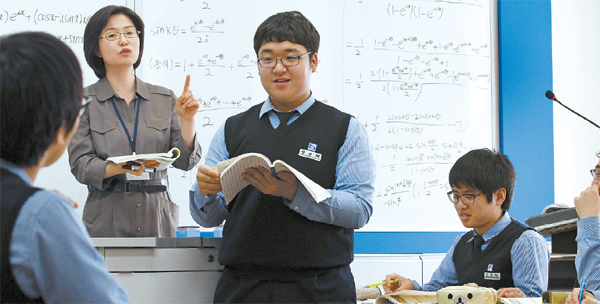Posh Seoul areas send more kids to top universities

A senior explains an equation in an advanced mathematics class on May 9 at Hwan-il High School in central Seoul, one of the few public schools not in the Gangnam and Seocho area to have a high ratio of students accepted to the top three universities in Korea. A recent study showed that the majority of the top ten regular high schools to send students to the “SKY” - Seoul National, Korea and Yonsei - universities were from the wealthy Gangnam and Seocho Districts in southern Seoul. By Choi Seung-shik
The high schools with the greatest number of students admitted to the coveted top three colleges, Seoul National, Korea and Yonsei Universities, also referred to as “SKY,” were confirmed to be in the posh Gangnam District in central southern Seoul.
The schools that sent over 100 students to SKY universities, Korea’s closest equivalent to the U.S. Ivy League, were Whimoon, Joongdong, Kyunggi and Dankook University High Schools in Gangnam District, with 128, 112, 101 and 100 students accepted respectively.
Joongdong High School had the highest ratio of students accepted to SKY universities, with more than one out of five students accepted.
The JoongAng Ilbo, in collaboration with Haneul Education, an entrance examination specialist company, analyzed Seoul’s regular school acceptance rates into SKY universities recently and revealed the results earlier this month.
Out of 208 regular high schools in Seoul, 133 schools had students that were accepted to these top three universities.
Analysis showed that Gangnam high school students make up 14.5 percent of students accepted to SKY universities.
Seocho, a wealthy southern Seoul district adjacent to Gangnam, had the second highest number of its high school grads head off to SKY, producing 11.1 percent of the new freshman class.
The analysis also indicated that the rate of matriculation into the SKY schools was proportionally lower the lower the student’s household income was.
Of the top five schools with the highest acceptance rate into SKY universities, only 4 percent of students received lunch money support from the Ministry of Education, Science and Technology because of their household situation.
Han Sang-jin, professor of sociology at Seoul National University, said, “Acceptance rates into top universities are an important means of detecting mobility in our socially stratified society. The reality of the present situation is that opportunity in education has incrementally become unequal - and ‘a dragon cannot spring out from a small creek.’”
Of the top seven regular high schools that produced the highest ratio of acceptances into the SKY universities, Hwan-il High School in central Seoul, ranked seven, was the only school not from Gangnam or Seocho District.
Compared to the Gangnam schools, Hwan-il High has 11 percent more students receiving meal support fees.
But despite students coming from lower-income households, Hwan-il High School produced 73 students accepted into to one of the top three universities, 2.5 times the number of students it dispatched in 2007, with just 28 students.
Their strategy is offering special advanced classes to their students in subjects like mathematics and English and offering a well-rounded education.
Oh Hye-gyeong, a math teacher at the school, said, “The students learn material that is not included in even the top schools.
To brace for more difficult college essay examinations and in order to be competitive against science high schools, the accelerated courses have become a part of the regular curriculum.”
The school employs other innovative measures to make sure all students are on a level platform in terms of education, such as running freshmen through middle school material to refresh them on the basics.
They also are provided more classes in English and math than other high schools, offering a mandatory “math basics” and “advanced math.”
The school further encourages students to prepare presentations and promote discussion and debate in order to break free from the rote-learning system that Korean education is usually dependent on.
After-school classes offered by Hwan-il High have also seen a high participation rate, with 94 percent of its students opting to take classes in over 60 additional subjects.
Some 91 percent of students also participate in the voluntary evening review classes that run from 7 p.m. to 11 p.m.
The principal of the school further stated that students who have different weaknesses need to have “them pinpointed with tweezers” and have teachers who can cater to the individual student.
Parents laud the system, and 47-year-old mother Jeon Jye-hyeong said, “The school provides everything for the students so it is not necessary to send my child to a hagwon (private academy). Some families move into the neighborhood just to send their kids to Hwan-il High,” she said.
The school was awarded by the education ministry for its role in boosting higher education and over 20 schools have visited the campus to use the school as an educational benchmark.
By Yoon Seok-man, Sung Si-yoon [sarahkim@joongang.co.kr]










with the Korea JoongAng Daily
To write comments, please log in to one of the accounts.
Standards Board Policy (0/250자)